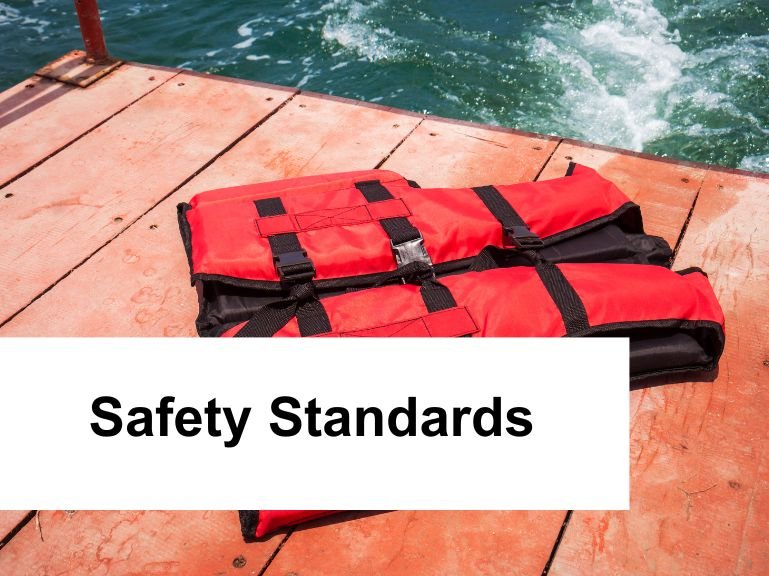Boating Regulations: Safety Standards
Boating, a leisurely pastime enjoyed by millions, demands a robust understanding of safety standards and regulations. Navigating the waters safely hinges on adhering to these guidelines, which are crucial for preventing accidents and ensuring enjoyable experiences. This article delves into the critical aspects of boating regulations, focusing on safety standards that every boater must know.

Key Takeaways
Understanding and compliance with boating safety regulations are vital for all water enthusiasts.
Life jackets and personal flotation devices (PFDs) are non-negotiable essentials.
Awareness of state and federal boating laws ensures safer waterways for everyone.
Understanding Boating Regulations: A Federal Perspective
Boating safety regulations are not just recommendations but essential legal requirements. The U.S. Coast Guard sets minimum safety standards for recreational boats up to 65 ft (19.8m) in length. These include:
- Personal Flotation Devices (PFDs): For boats smaller than 16 ft, one approved Type I, II, III, or V PFD is required for each person onboard. Boats between 16 ft and 65.6 ft need similar PFDs, plus a throwable Type IV device. State laws may have additional requirements, especially for children.
- Sound Producing Devices: All boats under 65.6 ft must carry an efficient sound-producing device, while those larger need a whistle and bell audible for 1 nautical mile.
- Visual Distress Signals: Boats under 16 ft require night-time visual distress signals, while larger boats need them for both day and night.
- Fire Extinguishers: Depending on the boat’s size, specific types and numbers of fire extinguishers are mandated.
Understanding these federal regulations is just the starting point. For a detailed guide, visit the U.S. Coast Guard’s boating safety division.
State-Specific Boating Laws and Their Importance
State boating laws can vary significantly and are as crucial as federal regulations. They encompass a range of requirements, including boating safety courses, life jacket usage, and handling of boating under the influence. These laws are tailored to local waterways and conditions, making them vital for region-specific safety.
Essential Boating Safety Equipment
Equipping your boat with necessary safety gear is non-negotiable. Besides the basic requirements set by the Coast Guard, consider these additional items:
- Ventilation Systems: Different regulations apply based on when your boat was built, especially concerning gasoline engine compartments.
- Back Fire Flame Arrestor: Required for each carburetor of gasoline engines installed after April 25, 1940.
- Navigation Rulebooks: Mandatory for boats over 40 ft.
Additional recommended items include a first aid kit, proper tools, a VHF radio, emergency fuel and water, a bilge pump, sunscreen, and an anchor to .
Weather Awareness and Handling Emergencies
Boaters must be vigilant about weather conditions, as weather can rapidly change on the water, creating hazardous situations. The U.S. Coast Guard advises staying updated with weather information and avoiding boating during inclement weather. Key signs of approaching bad weather include darkening clouds, sudden temperature drops, and increasing wind speeds. Being able to recognize these signs and react accordingly is essential for safety.
Staying Safe in a Storm
If caught in a storm, there are critical steps to ensure safety:
- Ensure everyone is wearing a life jacket, seated near the boat’s centerline.
- Secure all items on the boat to prevent them from filling with water.
- Turn on running lights and reduce speed to maintain forward motion.
- Head into waves at a 45-degree angle.
- In case of engine failure, use a sea anchor or a bucket to keep the boat stable.
The Role of Education and Preparation in Boating Safety
Education plays a pivotal role in enhancing boating safety. Statistics show that the majority of boating fatalities occur when operators lack a nationally-approved boater safety education certificate. Most states mandate boating safety courses, which can be lifesavers, teaching crucial emergency handling and safety measures.
Boat Safety Check and Equipment Checklist
Before every boating trip, it’s crucial to:
- Check the forecast and plan trips during favorable weather.
- Familiarize yourself with your boat and its safety equipment.
- Inform a trusted person about your float plan, including departure and arrival times, and passenger details.
- Inspect the boat thoroughly, checking fuel levels, steering, throttle controls, and ensuring the battery is fully charged.
- Have a communication plan, including cell phones and radios.
FAQs
Q: What are the top causes of boating accidents?
A: Common causes include inattention, inexperience, and machinery failure. Alcohol use is a leading factor in fatal accidents.
Q: How can I ensure my life jacket fits correctly?
A: Ensure it’s U.S. Coast Guard approved, fits your size and weight, and doesn’t ride up over your chin or face.
Q: Where can I find state-specific boating safety courses?
A: The BoatUS Foundation offers free online courses tailored to each state.
Conclusion
Understanding and adhering to boating regulations and safety standards are imperative for every boater. By staying educated, prepared, and aware, boaters can significantly reduce the risks associated with this enjoyable activity. Remember, safe boating is responsible boating.
